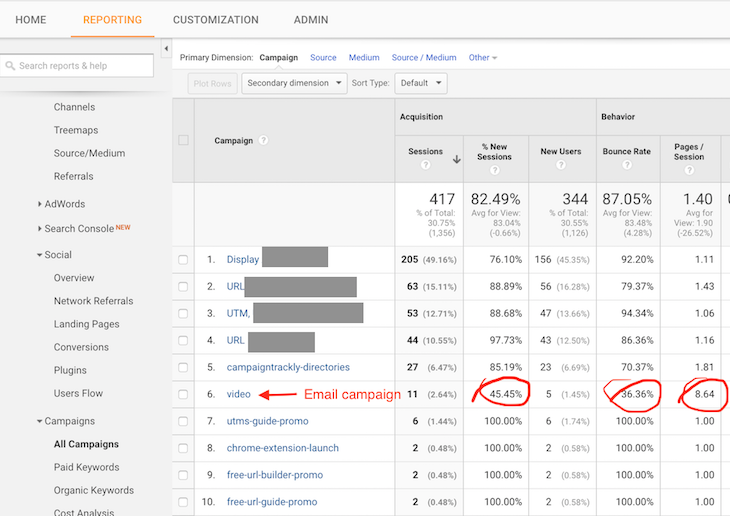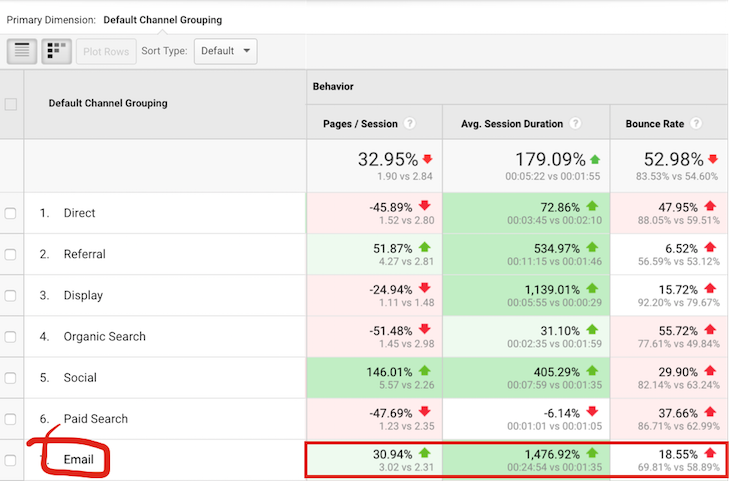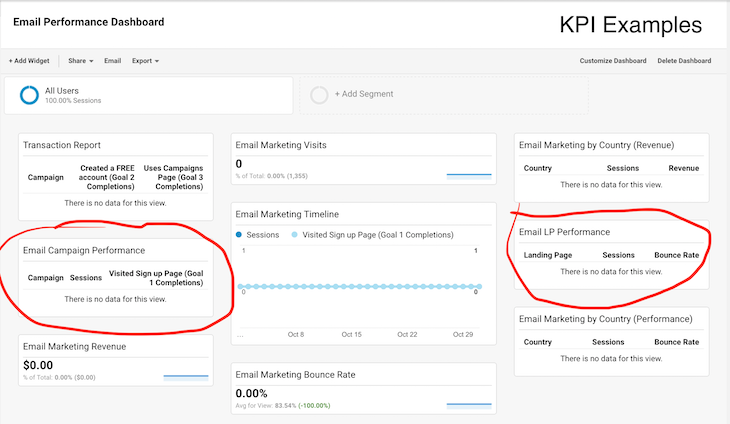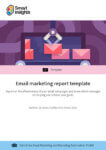Are you struggling to measure the impact of your email program and is reporting taking too much time?
Then, you might want to consider tracking your email efforts in Google Analytics (GA). Here are ten rock-solid, performance-driven reasons why you should do just that:
1. Capture Email KPIs After the Click
“Don't skip this part - what happens after that email click will either deliver high conversions or kill the most valuable offer you ever had.”
Avinash Kaushik, Digital Marketing Evangelist, Google
Most Email Service Providers (ESPs) offer a fairly standard set of metrics that track the performance of your email, including open, click-through, bounce rates and unsubscribe rates.
What is really rare?
Insights about user behavior after the click.
Why would you need after-click insights?
Email is a core digital channel and marketers spend a great deal of time building their mailing lists. In fact, list building is a top challenge for most marketing specialists.
Because it is so tough to get the recipients to opt in and so easy to lose them - they can unsubscribe with a click - it is extremely important that we keep them interested and engaged in our email programs.
And here is where measuring after-click behavior is critical. One look at the bounce rates and time spent on the website generated by an email can tell you immediately if your email asset is meeting the expectations of your audiences.

This "Campaigns" report available in Acquisition>Campaigns>All Campaigns shows that the sessions generated by a video email last much longer and have significantly lower bounce rates
If you have set up goals for this email, you can see instantly if any conversions are happening. If not, you immediately know there is a problem, and you can start investigating and fixing things right away.
What will Google Analytics show you?
All the after-click intelligence in one simple report. You can quickly view the bounce rates of the landing pages your email promoted. You can also check visit depths and actions (or goals) completed as a result of your email.
Why should you do this?
These are the KPIs you want to report on when it comes to measuring the impact of our email programs. Your decision-makers rarely care about open rates; they want to know the bottom-line effect of marketing investment.
Further reading
For more detailed explanation about measuring behavior after the click, you can check out Avinash Kaushik's excellent email metrics blog available here.
Email marketing report template
Report on the effectiveness of your email campaigns and know which messages are helping you achieve your goals with our simply report template. We'll guide you through every step of creating a concise, actionable report.
Access the Email marketing report template
2. Get Demographic Insights
Google Analytics collects great demographic information about your visitors. You can get a fairly extensive view of your email audience in just a few clicks. Important data to look at includes age, gender, interests, location, number/frequency of visits to the site, etc.
Why would you need these insights?
Because you want to slice and dice your audience in smaller, tighter segments, so that you can send them better-targeted email offers and content. This will make them happy and would result in improved acquisition and behavioral KPIs.

3. Put Email Traffic on the Analytics Radar
Google Analytics comes with several out-of-the-box traffic source presets. They include organic search, paid search, social media, referrals, direct, and other. Email is not included because different businesses use different email service providers.
Why would you need these insights?
Once you set up email as one of your website traffic sources, you can easily compare how well it performs against your other traffic channels. The chances are that your work will shine when you show in direct comparison how much better email performs in terms of key KPIs, including time spent on the website, actions (goals) completed, visit depths, and visit frequency.

This "Sessions vs Bounce Rates" report available in Audience>Benchmarking>Channels reveals that our email program performs much better than the rest of the industry in terms of pages/session and session duration, but under-performs in terms of bounce rates. The report has been truncated to reduce clutter.
4. View How Individual Emails Contribute to Campaigns
While your All Traffic reports will show you how your email efforts stack up against the rest of your generic traffic sources, GA's Campaign report enables you to get much more granular feedback about your work.
Why would you need these insights?
Once you start tracking email, you can compare how well users responded to a specific campaign on Twitter versus a single email (or series of emails). This way you can easily compare how different channels contribute to the success of each one of your campaigns.
This can help you make an informed decision about tweaking budgets, resources, asset use, and more.
You can find out, for example, that Twitter is driving much more traffic than Email, but converting far fewer prospects.
Conversely, you can see that LinkedIn gives you a lot less traffic than Email, but is much more efficient relative to completed actions.
5. Compare the Performance of Individual Emails Links
Why would you need these insights?
Because you want to know if your recipients loved your email promo, but didn't like the landing page (not to point fingers, of course - to optimize your pages). Or, that they happily downloaded a free eBook and watched a product video even though they didn't take you up on your promo offer.
Reviewing link performance is an excellent way to identify the best traffic and engagement "generators" for your segments. You can sometimes even uncover brand new audiences for a blog or a product offering by tracking your links, especially when you combine this analysis with your demographic data.
And when you use tracking links, Google Analytics helps you see in seconds if what you are offering resonates with your audience's interests by letting you compare bounce rates, time spent on the page, and the next steps of the visitor's journey relative to that individual click.
If your bounce rates are high but time spent on the page is fairly long, this might mean that your blog is working well for your audiences, but you need to add more engaging offers in it. If your bounces are high and the visitors spend only seconds before they move on to the next page, you need to provide better matching content in your next email.
Individual links also let you find the answers to important acquisition questions, such as what generates more traffic and engagement - buttons, text links or image links, or what gets more clicks - your blog title, or the call to action associated with it, etc.
Combining link analysis with your demographic reports, for example, can quickly show you if your younger cohorts respond better to visual content versus text. This can be very helpful in segmenting your audience so that you can improve clicks and conversions with as little effort as possible.
6. Offload All Your Reporting Work & Save Time
Once you set up your tracking process, you can completely automate your reporting, which can save you a significant amount of time!
Why do this?
Google Analytics has a vast resource of ready-made dashboard templates that you can import with a push of a button.
They can be used immediately. You are saving a tremendous amount of time because you don't have to build those reports and dashboards yourself.
And it takes seconds to access everything you need to see in regards to your email program - all in one page.
Here is a very useful dashboard that you can import into your Google Analytics to measure email performance.

In this example, the "Email Performance" dashboard gives you instant visibility to some of your top email KPIs. It takes seconds to export or email the report to your stakeholders.
7. Automate Report Distribution - Save Even More Time
GA lets you "subscribe" your stakeholders to certain reports. Once you start getting email data in your platform, you should consider using this great service.
Why do this?
The reasons are obvious:
- keep your stakeholders happy
- give them the visibility they need to make informed decisions about campaigns, programs, and tasks
- save a huge amount of time because you no longer need to drop everything in order to build a custom report for each new ad-hoc request.
8. Control What Info You Are Sharing
You might choose not to share everything relative to your email program performance. Or you might want to customize reporting formats and data depending on who you are sending it to - stakeholders, peers, or higher-level management.
Google Analytics gives you incredible flexibility with their custom reports, where you can drag and drop different data and reformat what you are sharing with a click of a button.
Why do this?
Be in control of your reports without spending too much time. Automate and customize content feedback based on the individual needs of your stakeholders.
9. You can also track email opens and clicks in GA
Google Analytics enables you to setup email open and clicks performance tracking via a few lines of code. You can capture individual email performance via the Events report.
Why do this?
If your email service provider doesn't allow you to subscribe your stakeholders to individual email reports, you can use Google Analytics to automate this task for you. Because reports can be generated and emailed in seconds, the best benefit that you are getting here is time.
10. Real-time performance tracking for free
Google Analytics lets you view real-time data.
Why would you need these insights?
This enables you to watch live the effect an email has on your website's traffic and user behavior. As an example, if you see that too many people are suddenly dropping off the e-commerce landing page that your email has taken them to, you might be experiencing a server issue.
If it is an easy fix and you take urgent action, you might be able to salvage the rest of your campaign.
Conclusion
If it takes you too long to build and share email reports with your stakeholders, or if you want to get more out of your email program and drive better results, you should consider tracking your efforts in Google Analytics.
Putting everything in place can be fast and simple - your one-time setup involves adding a few lines of code, which can be implemented by your programming or IT team. And if you are concerned about the tagging aspect of it - building tracking links is no longer the chore that it used to be, especially with free automated link builders such as CampaignTrackly that are readily available on the market.

Thanks to Milena Mitova for sharing their advice and opinions in this post. Milena Mitova is a digital marketing acquisition and automation expert. A technologist and blogger, she has just joined the Cambridge Marketing College as a tutor and often writes for the Digital Doughnut. Milena has worked at or consulted for small and large international companies, including Nestle, Shell, Honeywell, Equinix, and ARM. Currently celebrating 14 years of impactful results: 256 digital marketing projects, 15 certifications, six awards.








 Thanks to Milena Mitova for sharing their advice and opinions in this post. Milena Mitova is a digital marketing acquisition and automation expert. A technologist and blogger, she has just joined the Cambridge Marketing College as a tutor and often writes for the Digital Doughnut. Milena has worked at or consulted for small and large international companies, including Nestle, Shell, Honeywell, Equinix, and ARM. Currently celebrating 14 years of impactful results: 256 digital marketing projects, 15 certifications, six awards.
Thanks to Milena Mitova for sharing their advice and opinions in this post. Milena Mitova is a digital marketing acquisition and automation expert. A technologist and blogger, she has just joined the Cambridge Marketing College as a tutor and often writes for the Digital Doughnut. Milena has worked at or consulted for small and large international companies, including Nestle, Shell, Honeywell, Equinix, and ARM. Currently celebrating 14 years of impactful results: 256 digital marketing projects, 15 certifications, six awards.


